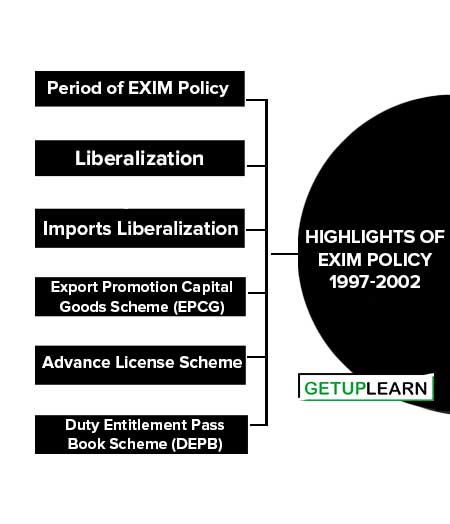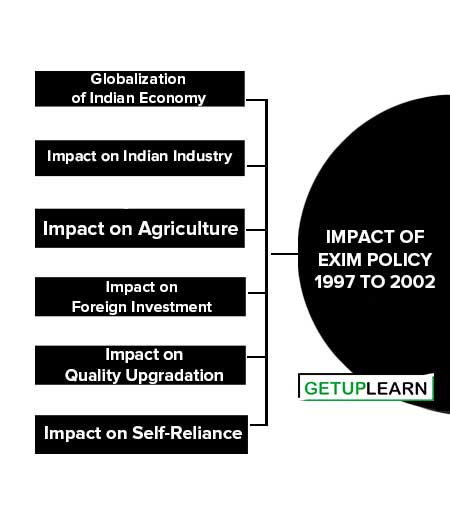Table of Contents
What is EXIM Policy?
In India, economic reforms took place in 1991 with the introduction of the LPG (Liberalization, Privatization, and Globalization) Policy. In order to liberalize imports and boost exports, the Government of India for the first time introduced the Indian EXIM Policy on April I, 1992.
In order to bring stability and continuity, the Export-Import Policy was made for a duration of 5 years. However, the Central Government reserves the right in the public interest to make any Export Import Policy is believed to be an important step towards the economic reforms of India.
EXIM Policy 1997 to 2002
With time the EXIM Policy 1992-1997 became old, and a New Export Import Policy was needed for the smooth functioning of the Indian export-import trade. Hence, the Government of India introduced a new EXIM Policy for the year 1997-2002.
This policy has further simplified the procedures and reduced the interface between exporters and the Director General of Foreign Trade (DGFT) by reducing the number of documents required for export by half. Import has been further liberalized and better efforts have been made to promote Indian exports in international trade.
Objectives of EXIM Policy 1997 to 2002
The principal objectives of the Export-Import Policy 1997 to 2002 are as under:
- To accelerate the economy from a low level of economic activities to high level of economic activities by making it a globally oriented vibrant economy and to derive maximum benefits from expanding global market opportunities.
- To motivate sustained economic growth by providing access to essential raw materials, intermediates, components,’ consumables, and capital goods required for augmenting production. To improve the technological strength and efficiency of Indian agriculture, industry, and services, thereby, improving their competitiveness.
- To create new employment. Opportunities and encourage the attainment of internationally accepted standards of quality.
- To give quality consumer products at practical prices.
Highlights of EXIM Policy 1997-2002
- Period of EXIM Policy
- Liberalization
- Imports Liberalization
- Export Promotion Capital Goods Scheme (EPCG)
- Advance License Scheme
- Duty Entitlement Pass Book Scheme (DEPB)

Period of EXIM Policy
This policy is valid for five years instead of three years as in the case of earlier policies. It is effective from 1st April 1997 to 31st March 2002.
Liberalization
A very important feature of the policy is liberalization. It has substantially eliminated licensing, quantitative restrictions, and other regulatory and discretionary controls. All goods, except those coming under the negative list, may be freely imported or exported.
Imports Liberalization
Out of 542 items from the restricted list, 150 items have been transferred to Special Import License (SIL) list and the remaining 392 items have been transferred to Open General Licence (OGL) List.
Export Promotion Capital Goods Scheme (EPCG)
The duty on imported capital goods under EPCG Scheme has been reduced from 15% to 10%. Under the zero-duty EPCG Scheme, the threshold limit has been reduced from Rs. 20 crores to Rs. 5 crores for agricultural and allied Sectors.
Advance License Scheme
Under Advance License Scheme, the period for export obligation has been extended from 12 months to 18 months. A further extension for six months can be given on payment of 1 % of the value of unfulfilled exports.
Duty Entitlement Pass Book Scheme (DEPB)
Under the DEPB Scheme, an exporter may apply for credit, as a specified percentage of the FOB value of exports, made in freely convertible currency. Such credit can be utilized for the import of raw materials, intermediates, components, parts, packaging materials, etc. for export purposes.
Impact of EXIM Policy 1997 to 2002
Impact of EXIM Policy 1997 to 2002 on the Indian economy:
- Globalization of Indian Economy
- Impact on Indian Industry
- Impact on Agriculture
- Impact on Foreign Investment
- Impact on Quality Upgradation
- Impact on Self-Reliance

Globalization of Indian Economy
The EXIM Policy 1997-02 was proposed with the aim to prepare a framework for the globalization of the Indian economy. This is evident from the very first objective of the policy, which states.
“To accelerate the economy from a low level of economic activities to a high level of economic activities by making it a globally oriented vibrant economy and to derive maximum benefits from expanding global market opportunities.”
Impact on Indian Industry
In the EXIM policy 1997-02, a series of reform measures have been introduced in order to give a boost to India’s industrial growth and generate employment opportunities in the non-agricultural sector.
These include the reduction of duty from 15% to 10% under the EPCG scheme that enables Indian firms to import capital goods and is an important step in improving the quality and productivity of the Indian industry.
Impact on Agriculture
Many encouraging steps have been taken in the EXIM Policy 1997-2002 in order to give a boost to the Indian agricultural sector. These steps include the provision of an additional SIL of 1 % for the export of agro products, allowing EOUs and other units in EPZs in agriculture sectors to 50% of their output in the domestic tariff area (DTA) on payment of duty.
Impact on Foreign Investment
In order to encourage foreign investment in India, the EXIM Policy 1997-02 has permitted 100% foreign equity participation in the case of 100% EOUs, and units set up in EPZs.
Impact on Quality Upgradation
The SIL entitlement of exporters holding ISO 9000 certification has been increased from 2% to 5% of the FOB value of exports, which has encouraged Indian industries to undertake research and development programs and upgrade the quality of their products.
Impact on Self-Reliance
The EXIM Policy 1997-2002 successfully fulfills one of India’s long terms objectives of Self-reliance. The EXIM Policy has achieved this by encouraging domestic sourcing of raw materials, in order to build up a strong domestic production base. New incentives added to the EXIM Policy have also added benefits to the exporters.
EXIM Policy 2002 to 2007
The EXIM Policy 2002 – 2007 deals with both the export and import of merchandise and services. It is worth mentioning here that the EXIM Policy: 1997 – 2002 had accorded the status of the exporter to the business firm exporting services with effect from 1.4.1999. Such business firms are known as Service Providers.
Objectives of EXIM Policy 2002 to 2007
The main objectives of Export-Import Policy 2002-2007 are as follows:
- To encourage the economic growth of India by providing the supply of essential raw materials, intermediates, components, consumables, and capital goods required for augmenting production and providing services.
- To improve the technological strength and efficiency of Indian agriculture, industry, and services, thereby improving their competitive strength while generating new employment opportunities and encouraging the attainment of internationally accepted standards of quality.
- To provide consumers with good quality products and services at internationally competitive prices while at the same time creating a level playing field for the domestic producers.



